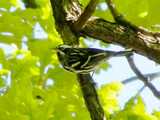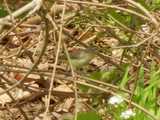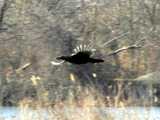Last updated: Jun 6th, 2011
Birding in Philadelphia:
My Experience with Birding Sites in Philadelphia:
This article is about my experience with sites for birding (birdwatching) within the city limits of Philadelphia, PA. Most of Philadelphia is very urban, dense, and almost completely developed and built-out. Nonetheless, there are a surprising number of great sites for birdwatching in the city limits.
Why bird in Philadelphia?
Most birders in the Philadelphia area have historically chosen to bird outside the city limits. For example, if you check the websites of local birding clubs, you will see that a majority of their trips are to quite far away, areas such as Delaware (state, not county). While these are valuable trips (having lived in Delaware for four years I will testify to its amazing birdwatching opportunities), I think that birding in the city is a much neglected practice that has potentially huge benefits.
The benefits of birding in the city of Philadelphia:
- If you are a Philly resident, birding the areas closest to you can help reduce the time, money, and natural resources spent on travel (usually by driving) to other places to bird.
- Again for Philly residents, if you bird areas close to you, you will be able to visit them more frequently, thus gaining a more intimate understanding of their ecology, and the lives of the birds that live in these areas.
- Birding in the city, where species richness is often lower than in natural areas (although not as low as you might expect!) can help get you out of the "more species is better" attitude. The purpose of birding is not to see as many species as possible, but rather, to have fun and to learn about birds and ecology with an eye towards conserving and protecting natural resources.
- Birding in highly urban areas raises awareness of how small decisions in land use and landscaping can have big ecological impacts.
- Birding in the city is a highly visible activity and can be good publicity, to draw others into the practice of birdwatching, and ultimately, to help make others more aware of nature and ecology in general.
A note on safety:
Some of the areas in Philadelphia that are good for birding are not necessarily the safest places to be while alone. I am writing about these sites strictly from a birding and ecological perspective and am making no claims about the safety of birding in these areas. Exercise caution, and when in doubt, do your research before birding an unfamiliar area.
West Philadelphia Birding:
I spend more time in West Philadelphia than in any other part of the city, so this is the area where I know the most birding sites:
- The Woodlands (Cemetery) - Most well-known as a cemetary, this area is also an arboretum and historic site. Its main entrance is located directly across from the 40th street trolley portal, where Baltimore and Woodland avenues branch out. This site is open daily, but does not generally open until 9AM. Being the largest spot of greenspace in the vicinity, it is a natural migrant trap during migration. It also has a substantial amount of wild brush around the edges, and is on a hill with a substantial view of the Schuylkill river. Please be respectful of the fact that this site is a cemetery if you choose to bird here. More info on this site can be found on the official site, The Woodlands - Historic Mansion, Cemetary, and Landscape or on The Woodlands (Philadelphia, PA) - Wikipedia.
- Cobbs Creek Park - Located on the western border of the city limits of Philadelphia, this creek has wild wooded areas along a creek. There are numerous access points, but a convenient one is at the end of Catharine St., on Cobbs Creek Parkway. The Cobbs Creek Community Environmental Education Center is located here, and has a parking lot and convenient access to trails through this relatively narrow, but outstanding birding area. Wikipedia has a good page on Cobbs Creek.
- Bartram's Garden - Bartram's Garden, located at the end of 53rd street off of Lindbergh Blvd, is the oldest botanical garden in the United States. In addition to the garden itself, the grounds have considerable wild areas, including a grassland and a wild forest area, both adjacent to the Schuylkill river. The river is fairly accessible, with paths bringing one close enough to closely view mudflats on the river. Bartram's Gardens are open to the public for free, but the gardens request that you make a donation to support their ongoing maintenance. You can read more about Bartram's garden on Wikipedia.
- Kaskey Park - Kaskey park is a small park nestled in between large buildings on a strange corner of Penn's campus, just east of University Avenue. This area is easily accessible only by foot. A rare island of greenspace, trees, and a pond in an otherwise very developed urban area, Kaskey Park has a surprising species richness of birds relative to its tiny size.
Other Philadelphia Birding Sites:
- John Heinz National Wildlife Refuge at Tinicum - The John Heinz National Wildlife Refuge at Tinicum is located north of I-95, directly across from the Philadelphia International Airport. Part of the refuge is contained in the city limits (with the other part in Delaware county), making this one of the best birding sites in the city. There is no entrance fee and there is a large visitor's center and ample free parking. This is an extensive refuge that one could easily spend all day birding in. Highlights include walkways in and near wetland areas, an observation tower, and some forested areas as well.
- Franklin Delano Roosevelt Park - South Philadelphia is notably sparse on good birding sites, but at the far south end of the city lies this extensive park. Although most of the park consists of mowed lawns, the park is definitely the largest green space in South Philadelphia, and also has a substantial amount of water. which makes it a notable birding site for people wishing to bird in South Philadelphia. There is little wild forest, but there are extensive scrubby areas and some wetlands; the best place I've found in this park is on the isthmus between Meadow Lake and the large lake, and the wetlands near this area. The edges of the other small ponds throughout the park are also good birding spots.
- Fairmount Park - Fairmount park is not one park but rather, an extensive system of parks within the city limits of Philadelphia. When people say "Fairmount park" they usually are referring to the section of the park which extends on both sides of the Schuylkill river, northwest from the downtown. This park contains some of the largest sections of wild forest within the city limits, and there are numerous good birding sites throughout this part of the park system. One particularly notable birding site in Fairmount park is Carpenter's woods, near Mt. Airy and Germantown, towards the northwest corner of Philadelphia.
- In far northeast Philadelphia, Pennypack park contains wild forests along the Pennypack creek. I have never birded this area, however, so I cannot say much about it.
Resources and Related Sites:
- eBird - I recommend for all birders to use eBird. Not only is eBird fun, easy-to-use, and can keep track of all your statistics and life lists for you, but eBird allows you to contribute your bird observations to a public database which is used to advance both science and conservation. eBird also lists hotspots (which include all the sites mentioned here and numerous others), and provides free access to data. Try it out: View eBird's data for Philadelphia county as a whole. Yes, you can see all of those 286 species, and possibly more, in the city limits.
- Delaware Valley Ornithological Club - A major Philadelphia birding organization, the DVOC hosts numerous field trips, including many that are free to non-members as well as members. The DVOC also has a good resource on birding sites in Philadelphia county (the city limits).
- Wyncote Audubon Society - Another birding organization near Philadelphia. Wyncote is one of Philadelphia's northern suburbs, but this club has field trips travelling in all directions.
Comments are moderated. Follow Cazort.net's comment policy for your comment to be approved.
blog comments powered by Disqus

